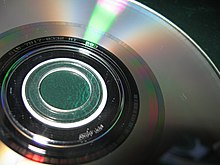GD-ROM
 |
|

The underside of a GD-ROM disc
|
|
| Media type | Optical disc |
|---|---|
| Capacity | 1 GB |
| Developed by | Yamaha |
| Usage | |
GD-ROM (an abbreviation of "Gigabyte Disc Read-Only Memory") is a proprietary optical disc format originally used for the Dreamcast video game console, as well as its arcade counterpart, the Sega NAOMI and select Triforce arcade board titles. Developed by Yamaha, Sega intended to use the format to curb piracy common to standard compact discs and to offer increased storage capacity. It is similar to the standard CD-ROM except that the pits on the disc are packed more closely together, resulting in a higher storage capacity of around 1 gigabyte, a 25% increase over a conventional CD's capacity of 700 megabytes.
Sega's use of the format instead of the new DVD-ROM technology supported by the PlayStation 2 and Xbox has been considered a mistake that contributed to the Dreamcast's early demise. The DVD-ROM format allowed for larger storage capacity than the GD-ROM, as well as support for DVD Video playback, which by then became the accepted standard format for home video. Furthermore, the use of GD-ROMs was the Dreamcast's only method of anti-piracy protection, which contributed to the system's rampant piracy problem once its support for MIL-CDs was discovered and exploited. Despite the failure of the Dreamcast, Sega continued to use the GD-ROM format in arcades with the Sega NAOMI 2, Sega Chihiro and Triforce.
The format was developed for Sega by Yamaha, and first commercially appeared with the Dreamcast's Japanese launch in November 1998. GD-ROM was created because the standard CD-ROM was prone to piracy and reaching the limits of its storage capacity, while implementing the new DVD-ROM technology would have made console production too costly (in part because royalties had to be paid to the DVD Forum). The use of the GD-ROM format, however, contributed to a high failure-rate of Dreamcast laser pickups, because they had not been designed to handle GD-ROMs efficiently. In addition, the Dreamcast did retain the ability to read standard CD-ROM discs, and thus still suffered from software piracy as bootleggers managed to fit certain games on CDs and exploit the Dreamcast console's compatibility with the MIL-CD format.
...
Wikipedia
